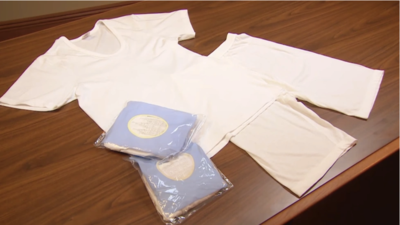
FAIR is a non-profit organization dedicated to providing well-documented answers to criticisms of the doctrine, practice, and history of The Church of Jesus Christ of Latter-day Saints.
FAIR Answers—back to home page

Members of The Church of Jesus Christ of Latter-day Saints perform several sacred ordinances or ceremonies for individuals that they believe are necessary for individual exaltation. A few of these ceremonies are performed in temples: holy places dedicated to serving God.
In the initiatory portion of the endowment, "the member is authorized to wear the temple garment. The garment represents his or her personal relationship with God and the commitment to obey covenants made in the temple."[1].
Members of the Church who go through these ceremonies and put on these sacred garments are sometimes confused as to two things:
This article seeks to answer these questions given what we know from official Church sources.
According to the official leadership handbook of the Church, “[m]embers who receive the endowment make a covenant to wear the temple garment throughout their lives.”[2] Among the questions asked to candidates for temple recommends is "[d]o you keep the covenants that you made in the temple, including wearing the temple garment as instructed in the endowment?" A "covenant" is defined by the Church (and, indeed, by most dictionaries) as “a sacred agreement between God and a person or group of people. God sets specific conditions, and He promises to bless us as we obey those conditions.”
Another way to argue that it is a covenant to wear the garment is to recognize that there is no substantive distinction between an instruction from God and a commandment. "Members who receive the endowment make a covenant to wear the temple garment throughout their lives." We covenant, both at baptism (Mosiah 18:8–10; Moroni 4:3; Doctrine & Covenants 20:37) and in the temple, to keep all of God’s commandments. Thus it is at least part of a covenant to wear our garments.
The official leadership handbook section on wearing the garment states that “[t]he garment should not be removed for activities that can reasonably be done while wearing the garment. It should not be modified to accommodate different styles of clothing. The garment is sacred and should be treated with respect. Endowed members should seek the guidance of the Holy Spirit to answer personal questions about wearing the garment.”
What are those activities where it might be unreasonable to wear the garment? Examples might include exercise or water activity.
As the quote states, the garment should not be removed nor modified to accommodate different styles of clothing. One of the purposes of the garment is to encourage modesty in how we dress. The garment as currently designed indicates what parts of the body should be clothed in order to meet a more objective/specific standard of modesty in how we dress.
Several concerns have arisen because of various health and practical considerations. The garment, as currently designed, can potentially assuage some of those concerns. If concerns persist, these might be directed to God in prayer.
Fundamentally, garments should not be removed when we have the reasonable opportunity to wear them and that, generally speaking, we should be seeking for opportunities to wear them rather than not wear them. Why would there be so many fabrics and styles that one can choose from if the Church didn't expect us to wear them as much as possible? We should be intuitive about our garment wearing and be in the communication with the Spirit to know when it may be necessary to remove them.
Wearing the garment is a sacred privilege. They are expressly not "just like any other underwear." Wearing the garment communicates love for God by keeping our promises to him and love for others by giving them an example to follow that leads them to Jesus Christ.[8] We often want so much to conform our garment-wearing to the world rather than help the world conform to garment-wearing. We shouldn’t be afraid to be different from others. The Lord has told us that, as Christians, we should “[l]et [our] light so shine before men [and women], that they may see [our] good works, and glorify [our] Father which is in heaven.”[9] He wants us to be "a peculiar people, zealous of good works."[10] Being different by wearing our garments and treating them with sacredness is an excellent way that we can humbly follow the Lord and, by so doing, be peculiar and interesting to other people. This interest may lead them to explore the teachings of the Church of Jesus Christ and be converted to it. Thus, by wearing the garment we can fulfill the Lord’s commandments. As Latter-day Saints, we should be model disciples of Jesus Christ. Wearing the garment is one way that we can do that and it brings tremendous spiritual blessings.
Notes

FAIR is a non-profit organization dedicated to providing well-documented answers to criticisms of the doctrine, practice, and history of The Church of Jesus Christ of Latter-day Saints.
We are a volunteer organization. We invite you to give back.
Donate Now